Dodge
Challenger Rear Brake Pads Replacement Guide
How to change the rear disc brake pads on
a 3rd generation 2008-2015 Dodge Challenger with photo illustrated steps.
By Paul B. Michaels Author & Photographer Auto Mechanic Since 1989 |
||
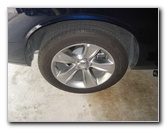 2015 Challenger Rear Wheel |
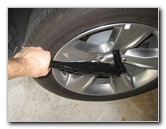 Slightly Loosen Lug Nuts |
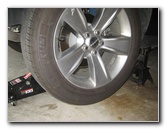 Raise Rear of Vehicle |
| This
automotive maintenance tutorial was specifically written to assist
owners of the third generation (2008, 2009, 2010, 2011, 2012, 2013,
2014, 2015 & most likely also the 2016 model year) Dodge Challenger in
changing the rear disc brake pads and lubricating the caliper slider
pins. Owners of other Chrysler, Dodge and RAM vehicles such as the Town & Country, 300, 200, Avenger, Charger, Journey, Dart, Durango, Grand Caravan, and Ram C/V Tradesman minivan may also find these DIY instructions to be helpful. The tools needed to complete this procedure include a tire iron, a floor jack, two jack stands, a 15mm socket with a 3/8" drive ratcheting wrench, an 18mm wrench or pliers, a "C" or "F" clamp and a tube of brake caliper grease. A few compatible replacement sets of new rear brake pads with their part numbers are as follows: Wagner ThermoQuiet PD1057, Bosch BP1053 or BP1057, Raybestos PGD1057C, Bendix D1057, Hawk Performance HB508Z.675, Centric 105.10530, Akebono ACT1057A, StopTech 309.10530, Dura International BP1057C and Bosch BE1057A. |
||
|
|
||
Please verify the correct replacement part numbers for your Challenger by calling your Dodge dealership's parts counter, an automotive parts store or the Amazon Part Finder website. It may vary depending on the model year and/or trim level. |
||
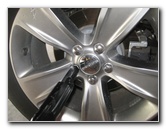 Spin Off 5 Lug Nuts |
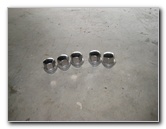 5 Lug Nuts Removed |
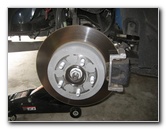 Rotor, Bracket & Caliper |
|
The first few steps are to park the car on a level surface, make sure that the the emergency / parking brake is not engaged and chock both sides of the front wheels to prevent it from moving. Slightly loosen the 5 lug nuts on the rear wheel by turning them counterclockwise with the tire iron. Raise the rear of the vehicle with the floor jack and securely support it with at least two jack stands. I prefer to work on one side of the car at a time to keep three wheels on the ground for extra safety. Spin off the 5 lug nuts and set them aside in a safe place. Pull off the rear wheel to reveal the rotor, bracket and caliper. |
||
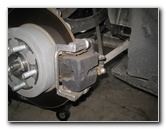 Rear Brake Caliper |
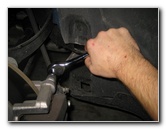 Loosen Upper Caliper Bolt |
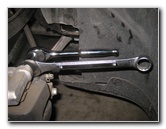 Hold Pin - 18mm Wrench |
The rear brake caliper is held in place to the bracket by two bolts on the back side of the caliper with the bolt heads facing in towards the trunk. Loosen the upper caliper bolt by turning it clockwise (as seen from the outside of the vehicle) with the 15mm socket and 3/8" drive ratcheting wrench. If the caliper slider pin turns as you are trying to loosen the caliper bolt, hold it in place with an 18mm wrench or a pair of pliers. |
||
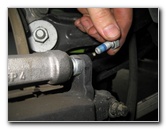 Spin Out Top Caliper Bolt |
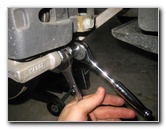 Loosen Lower Caliper Bolt |
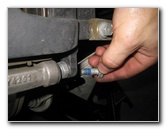 Remove Lower 15mm Bolt |
| Loosen the upper
15mm caliper bolt by turning it clockwise (as seen from the outside of the
vehicle) while holding the slider pin in place with the 18mm wrench. Spin out the two caliper bolts and set them aside in a safe place. |
||
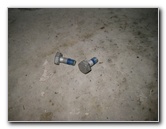 Two Caliper Bolts Removed |
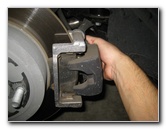 Pull Off Rear Brake Caliper |
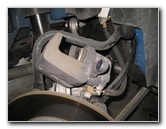 Rest Caliper On Suspension |
| Carefully pull the
brake caliper out of the bracket and off the old pads. Rest the caliper on the suspension or suspend it from the spring with a bungee cord or some twine. Try to avoid stressing, kinking, pulling or bending the rubber brake fluid line. |
||
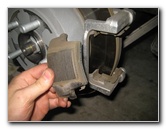 Wear Bar - Bottom Outer Pad |
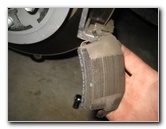 Wear Bar - Top Inner Pad |
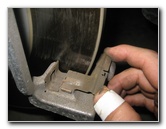 Replace Pad Abutment Clips |
| Pull the old brake
pads out of the bracket and make a mental note of where the wear indicator
bars
or "squeal" bars are located. On this 2015 Challenger 3.6L V6 model, the wear bars were situated at the bottom of the old outer pad and the top of the old inner pad. I recommend buying the Wagner ThermoQuiet PD1057 brake pads. I've always had great experiences with them and I really like how they don't need backing plates, shims or disc brake quiet gel due to the built in insulators. Thoroughly clean off the brake rotor, caliper bracket, brake caliper assembly and the lug nut studs with brake parts cleaner spray. Do not use compressed air or blow with your mouth to clean off the brake parts since breathing in brake dust can be harmful to your health. Brake dust may be carcinogenic (cancer causing) if inhaled. Apply a thin layer of brake parts lubricant grease to any area where there is metal to metal contact such as the outer lip of the caliper piston. Do not apply caliper grease to the friction surface of the new pads.
To remove the existing rotors and install new ones, remove the two bolts on the rear of the caliper bracket that attach it to the steering knuckle. Then loosen the old rotor with a rubber mallet, pull it off, and slide the new one in its place. If your new set of rear brake pads included replacement hardware, pull the old pad abutment clips or "anti-rattle" clips out of the top and bottom of the bracket before pushing the new ones in to place. Apply a small amount of synthetic high temperature brake parts lubricant grease to the pad abutment clips where they will come in contact with the new pads. |
||
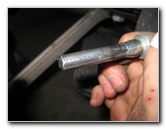 Lubricate & Replace Slider Pins |
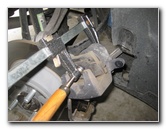 Attach "C" Clamp To Piston |
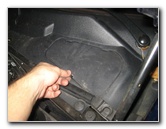 Pull Off Access Cover |
|
In order for the brake caliper to operate smoothly, the two caliper slider pins or "guide pins" need to be well lubricated. Pull the upper and lower caliper slider pins out of their rubber dust boots. Apply a thin layer of high temperature synthetic brake parts lubricant grease to the smooth parts of each slider pin before pushing them back in to their rubber dust boots. In order for the caliper to fit over the thicker new brake pads, you'll need to compress back the caliper piston. Attach the "C" or "F" clamp to the rear caliper and use the back of an old brake pad to evenly distribute the pressure across the piston. Move to the right rear are of the engine bay and pull off the plastic access panel on the driver side of the cowl. Set the access panel aside in a safe place. |
||
|
|
||
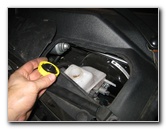 Twist Off Brake Fluid Cap |
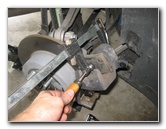 Compress Caliper Piston |
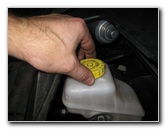 Replace Brake Fluid Cap |
| Twist off the
yellow plastic brake fluid reservoir cap in the counterclockwise direction. Removing the reservoir cap will allow the brake fluid to more easily travel backwards through the lines when you compress the piston. Slowly turn the "F" clamp handle in the clockwise direction to compress back the piston until it is flush with the rubber dust boot surrounding it. Repeatedly check the level in the brake fluid reservoir while you are compressing back the piston to make sure that it doesn't over flow. Wipe away any spilled brake fluid immediately and flush the area with water since brake fluid can easily damage painted surfaces. Replace the brake fluid cap as soon as possible by twisting it on in the clockwise direction. Brake fluid is hygroscopic and easily absorbs moisture from the air which can cause it to become contaminated and not work as well. |
||
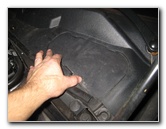 Replace Cowl Access Panel |
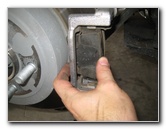 Install New Outer Pad |
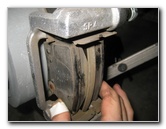 Push Pads Against Rotor |
| Re-insert the
plastic access panel in to the cowl. Install the new brake pads in to the bracket with the wear indicator bars situated at the top of the inner pad and at the bottom of the outer brake pad. Push the two pads together until they are flush against the rotor. |
||
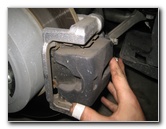 Lower Caliper Over Pads |
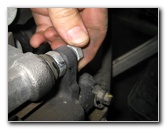 Spin In Top Caliper Bolt |
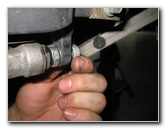 Spin In Bottom 15mm Bolt |
| Carefully lower the
caliper over the new pads and in to the bracket. If the caliper won't slide over the new pads, you may need to compress back the piston further. Spin in the two caliper bolts by hand a few turns in the counterclockwise direction (as seen from the outside of the car) to prevent them from becoming cross threaded. |
||
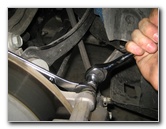 Tighten Upper Caliper Bolt |
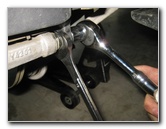 Tighten Lower Caliper Bolt |
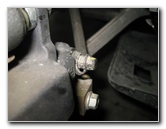 Rubber Valve Cap |
| Tighten the two
caliper bolts by turning them counterclockwise (as seen from the outside of
the vehicle) with the 15mm socket and ratcheting wrench to just past hand
tight or about 23 ft-lbs of torque. If the caliper slider pins turn as you are trying to tighten the caliper bolts, hold them in place with an 18mm wrench or a pair of pliers. If your brake pedal previously felt spongy or soft, the brake fluid may be contaminated with water or the brake lines may contain some air bubbles.It would be best to bleed the brake lines at this time in order to flush out the old fluid and replace it with fresh DOT 3 brake fluid. For more on this topic, check out my Brake Line Fluid Bleeding With An Assistant DIY Guide or alternatively the Brake Line Fluid Bleeding With A Power Bleeder Guide. |
||
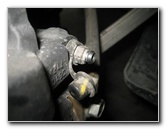 Brake Fluid Bleeder Valve |
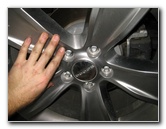 Push On Rear Wheel |
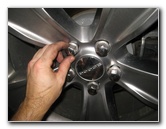 Spin On 5 Lug Nuts |
| The brake fluid
bleeder valve is located underneath a rubber cap on the back side of the
caliper just below the top caliper bolt. Push on the rear wheel and spin on the five lug nuts in the clockwise direction a few turns by hand to prevent them from becoming cross threaded. Slightly tighten the 5 lug nuts in a "star" or "criss cross" pattern with the tire iron. |
||
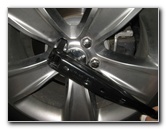 Slightly Tighten Lug Nuts |
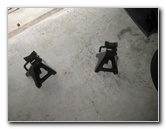 Lower Car From Stands |
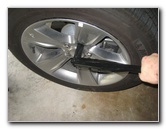 Torque To 100 ft-lbs |
| Use the floor jack
to carefully lower the rear of the car from the jack stands. Continue tightening the lug nuts in the clockwise direction to about 1/4 to 1/3 turn past hand tight or about 100 ft-lbs of torque. (Check your owner's manual, some Challenger models specify 110 or 130 ft-lbs of torque.) It would be best to use a torque wrench to make sure that the lug nuts are properly tightened. Sit in the driver's seat of the vehicle and pump the brake pedal a few times to restore the brake line pressure. Check the brake fluid in the reservoir and verify that it is at the proper level. If it is low, add some DOT 3 fluid. To break in your new rear brake pads, just drive normally for the first several hundred miles while trying to avoid any hard or "panic" stops which may glaze over the new pads and cause them to be noisy and not perform as well. It's also a good idea to regularly check your driveway or garage for drops of brake fluid which may indicate a leak, check the brake fluid level in the reservoir, and also verify that the lug nuts are still tight. For more,
check out my other
2008-2015 Dodge Challenger DIY Repair & Maintenance Guides. |
||
| If you found this guide to be helpful,
please consider making a small donation by clicking on the PayPal.com
"Donate" button located to the right of this paragraph. Thank you!
(Note: I am not a registered charity. Donations are not tax deductible.) |

